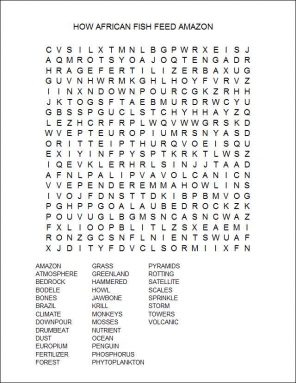How ancient African fish feed today’s Amazon
Dust from the driest desert on Earth nourishes tropical forests half a world away
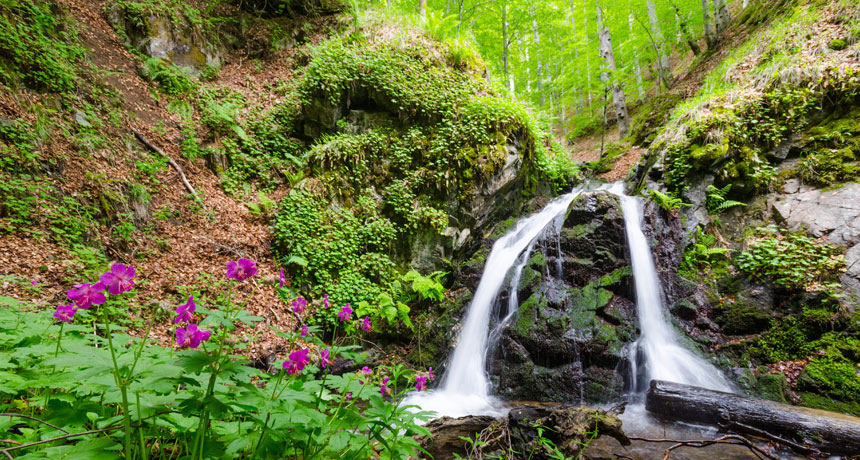
The lush, green landscape of the Amazon rainforest would not be possible without dust from faraway Africa.
zefart/istockphoto
By Douglas Fox
The second of two parts on the impacts of intercontinental plumes of dust. Find part 1 here.
It begins with a darkening sky, then a distant roar. Leaves rustle as monkeys scamper through the trees above. Drops of their pee sprinkle down through the leaves. Then they start to howl. It is more like a deafening yowl. Unseen in the trees overhead, a chorus of howler monkeys scream at the approaching storm.
Such storms are frequent in the Amazon. When Robert Swap was there years ago, he could sometimes see the dark wall of rain sweeping forward over the tops of the Amazon’s trees. He would be soaked the instant the storm arrived. A downpour might last 30 minutes. Then it would give way to a gentle sprinkle and the musty smell of wet leather. But what Swap remembers most of all is the dust.
Once a squall passed, he would find a film of red or brown dust blanketing his car. It was spattered on the windows, hood and roof of his little VW Gol. “Everything was wet,” he says. “It was humid. We had leather rotting. We had mold growing on everything. You couldn’t get dry. And yet you’d have this film of dust on top these cars. Where is this dust coming from?” Swap’s curiosity about that dust would lead to a surprising discovery about the secret life of the Amazon.
Swap was 20 years old during that trip in February and March of 1987. He had taken a semester off from college for what sounded like an exciting job. Michael Garstang was an atmospheric scientist at Swap’s school, the University of Virginia in Charlottesville. He needed helpers for a project in Brazil. Garstang was assembling a team to study late-afternoon storms. The group would drive into the Amazon on dirt roads. There, they would assemble metal towers that rose above the tree tops. From these lofty towers, they would measure the temperature, movement and moisture of air drifting over the trees.
For Swap, it turned out to be more hard work than high science. He hauled heavy loads and hammered stakes. He twisted metal screws two meters (6.5 feet) into the ground to anchor the wobbly towers. Dust had nothing to do with this project. Back then, few scientists cared about dust. But today, those old attitudes are starting to change.
Starving Amazon
Scientists have documented billions of kilograms of dust traveling the world. They increasingly see dust as a powerful force shaping Earth’s environment. Scientists now believe that without dust, the Amazon and some other big tropical forests might not exist. Instead, they might have died from malnutrition. At the very least, they would not host as much diverse plants and animals as they do today.
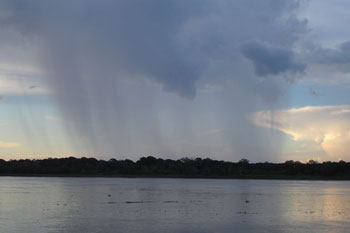
If that seems crazy, consider this: The lush, green Amazon actually lives on the edge of starvation.
To grow, plants need nutrients — such as phosphorus, calcium and magnesium. These minerals come from bedrock as it crumbles over thousands of years into soil. But they don’t stay put. Those minerals dissolve in water the same way table salt, also a mineral, will dissolve in a glass of water. Over millions of years, rainwater has leached rocky nutrients out of the Amazon’s soil. It has carried them into streams, rivers — and eventually out to sea. This is why the oceans are so salty. They are full of minerals washed off the land throughout Earth’s long history.
So it might seem strange, but the same heavy rain that quenches the thirst of the Amazon’s forests also steals their food. More rain steals more minerals, more quickly.
Ecologists have estimated that the Amazon needs twice as much phosphorus as comes out of its bedrock. But since the trees aren’t dying off, they have to be getting it from somewhere. The question has been: Where?
Swap stumbled onto the answer when he noticed all of that dust on his car in 1987.
Pyramids of dust
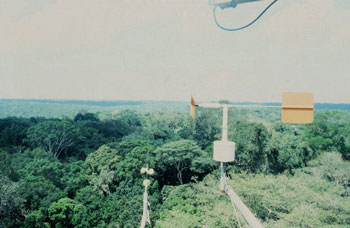
Before leaving Brazil to go home, Swap measured how much dust was collecting on the car. Months later, after getting home, he was also able to estimate how much dust was in the air high above the forest. Airplanes had collected samples of that air when Swap had been in Brazil. Those samples contained some dust that he was able to measure back home.
Over the next couple of years, Swap used this data to calculate how much dust was raining down onto the Amazon. He found that a single storm can drop nearly half a million tons of dust. And the entire Amazon might get 26 times that much each year. Pile it up, and you could build about five Egyptian pyramids!
Even if you look at smaller pieces of forest, that still works out to a lot of dust. A forested area the size of a U.S. football field would receive about 100 kilograms (220 pounds) of dust each year. That works out to between 1 and 2 kilograms (2 and 4 pounds) of phosphorus falling out of the sky each year. To buy that much phosphorus fertilizer for the entire Amazon, each year, would cost many millions of dollars.
So where was the dust coming from?
To answer that, Swap used data from weather satellites. These helped him reconstruct the air currents that delivered the dust. His findings, published almost a quarter-century ago, showed that those currents had to come from somewhere in North Africa. Most likely, the dust had come from the Sahara, a vast desert that covers most of that region. In just 10 or 12 days, he found, the dust travels 5,000 kilometers (more than 3,000 miles) across the Atlantic Ocean.
“It was pretty … cool,” he says, to find that something that is happening so far away could boost the health of the Amazon.
It is amazing enough to think that dust from the Sahara fertilizes the Amazon. But the truth is even more startling. Half of this dust actually comes from a single tiny source. It comes from an ancient, dry African lake bed. It covers an area of 10,000 square kilometers (4,200 square miles), equal to just two-tenths of one percent of the size of the Amazon forest it feeds.
Dead fish
This dry lake bed, called the Bodélé (Buh-DAY-lay) Depression, sits in a remote part of Chad. That nation lies on the southern edge of the Sahara. Satellite measurements show that the Bodélé is the dustiest place on Earth. It alone supplies one-sixth of all the dust that spends some time in the planet’s atmosphere. (The dust in your house, though, comes primarily from local sources — like laundry lint.)
Most places in the Sahara release the majority of their dust in summer. That dust rides winds high in the sky to Florida and the Caribbean Sea, to its south. But the Bodélé is different. It releases its dust in winter. Air currents shift at that time of year. And instead of carrying dust to the Caribbean, the winds ferry it southward — all the way to the Brazilian Amazon.
DUST IN THE WIND Satellites now track dust as it travels from Africa to the Amazon. NASA Goddard |
A scientist named Richard Washington led an expedition to the Bodélé Depression in 2005 (see Part I of this series). He is an atmospheric scientist from the University of Oxford. Based on data collected on that trip, Washington estimated that the Bodélé sends 23 billion kilograms (25 million tons) of dust to the Amazon each year. A newer estimate, published in 2015, suggests the true amount could be twice that high. This shows that the estimates Swap made in 1992, using far less information, were in the right ballpark. That study was “way, way ahead of its time,” says Washington. “Ridiculously ahead of its time.”
What’s more, Bodélé dust is full of what the Amazon needs most: phosphorus. Back in 2005, Washington’s team dug many holes in the Bodélé lake bed. The rock they excavated was sprinkled with the bones, scales and teeth of fish. Once they even spotted the meter- (yard-) long skeleton of a fish — a kind called Nile perch — embedded in the hard ground. These animals had died and sunk to the bottom of the lake some 6,000 years ago, when it still held water.
Fish teeth, bones and scales are known to hold lots of phosphorus. That phosphorus is part of a mineral called apatite (AA-pah-tyte). It dissolves exquisitely well in water — far better than other phosphorus minerals. And one benefit of that: Plants easily absorb it.
Up to half of the phosphorus in Bodélé dust actually comes from fish. Charlie Bristow, a scientist who studies lake sediments, reported this in 2014. He works at Birkbeck College at England’s University of London. He was also part of Washington’s 2005 expedition to Bodélé.
Stuff of life
Phosphorus has always been a limiting nutrient. It makes up, in part, a membrane that encloses every cell on Earth. Phosphorus atoms also form part of the backbone of the DNA found in every cell. This DNA provides instructions for the cell.
But phosphorus has always been hard to get. Much is locked away in rocks, deep underground. So all life struggles to acquire whatever phosphorus it can.
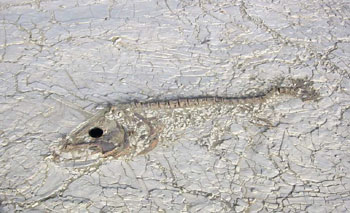
Thousands of years ago in Africa, millions of fish inhabited a lake the size of modern-day Pennsylvania. Bit by bit, its fish gathered phosphorus from the insects and algae they ate. In the very act of growing, they locked this precious substance into their bones, scales and teeth. When they died, their remains sank to the lake floor. There, they deposited their lifetime savings of phosphorus. As countless fish left their carcasses entombed in layers of sediment and stone, those stores of phosphorus grew.
Before the lake eventually dried up, billions of kilograms (millions of tons) of phosphorus may have built up in what would become known as the Bodélé Depression. The life’s work of fish that lived 6,000 years ago is now fueling the largest forest on Earth.
The Bodélé may be the most striking example of dust from one part of the world supporting far-away life, but it is not the only one. The more people look, the more common this seems to be.
Tropical forests in parts of the Hawaiian Islands may survive on mineral dust picked up by winds from deserts 8,000 kilometers (5,000 miles) away in Asia. “Hawaii actually receives very, very little dust by comparison to other parts of the Earth,” says Oliver Chadwick. But despite that, “we can very distinctly pick the signal of the dust out.” Chadwick is a soil scientist at the University of California, Santa Barbara. In the 1990s, he examined soils from across the Hawaiian Islands. In it, he found small amounts of several rare elements: thorium, europium (Yu-ROPE-ee-um) and neodymium (NEE-oh-DIM-ee-um). These elements are not normally found in the volcanic rocks that built these islands. That suggests they blew in from elsewhere.
Slimy dust eaters
Something similar happens in the continental United States. Nutrient-rich dust from the California’s Mojave (Mo-HAAV-ee) Desert blows hundreds of kilometers west into a region called the Colorado Plateau. This region spans much of Arizona, Utah, New Mexico and Colorado. A lot of this area sits atop sandstone bedrock that is poor in many of the nutrients that plants need. So the dust blowing in helps sustain forests of juniper and pinyon trees that might otherwise struggle.
Life on the Colorado Plateau has evolved to catch this dust and eat its nutrients. Walk through one of its open woodlands and the crusty soil breaks under your feet. But this “desert crust” is alive!
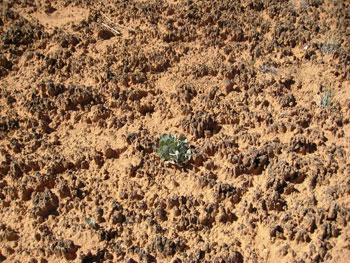
The crust is a patchwork of mosses and lichens. These are glued together into a mat of tiny organisms called cyanobacteria. Jayne Belnap works at the U.S. Geological Survey in Moab, Utah. There, she has spent years studying these living crusts. “Unlike plants, they don’t have roots,” she says. “They can’t run around and find nutrients” in the dirt. Instead, they catch them from the sky. The cyanobacteria ooze a sticky goo made of polysaccharide (PAH-lee-SAK-uh-ryde). Any fleck of dust that touches it gets caught in its grip so strongly that the wind cannot steal it away again.
“Dust is really a great thing,” says Belnap. “There’s this phenomenal role that dust has played in the evolution of all of these systems.”
Dust may even feed the oceans, notes Joseph Prospero. He’s an atmospheric chemist at the University of Miami in Florida. His calculations indicate that dust from Africa and Asia injects large amounts of iron into the world’s oceans. That iron helps drive the growth of itty-bitty organisms called phytoplankton (FY-toh-plank-tun). They, in turn, feed tiny crustaceans called krill, which are eaten by whales, penguins and some fish. That dust, in other words, helps sustain the entire ocean food web.
Dust “seems to have tentacles into all sorts of arenas,” says Washington. “It’s a connector across all sorts of ecosystems.” These long-distance dust connections have not been constant over time, and neither have the ecosystems that they feed.
Grim discovery
Washington’s team made a poignant discovery while they were exploring the Bodélé in 2005. One day they found a human skull and a jawbone jutting from the ground. The bones were still locked in hard stone. These appeared to be the remains of someone who died and sank to the bottom of the lake many thousands of years ago.
Those bones became buried on the lake bottom. And they stayed suspended in those layers as the world above changed and the lake dried. Winds began to chew on the exposed lake bed. Every year, those winds skimmed a little bit more of the sedimentary stone off the ground’s surface. Eventually, this erosion brought the bones back into daylight, for the first time in thousands of years.
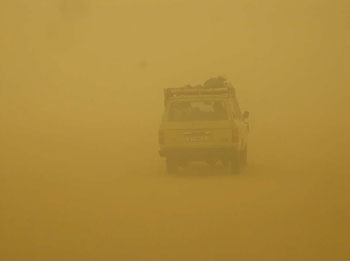
Washington estimates that wind continues to blast one to three penny thicknesses of stone off the top of the lake bed each year. On the north edge of the Bodélé, these winds have removed 4 meters (13 feet) of solid stone from the lake bed. Only a few wind-carved ridges of that stone still remain. Washington figures that this same thickness of stone has been blasted off most of the Bodélé lake bed over the past several thousand years.
As such, this source of dust and plant nutrients won’t last forever, says Washington. This became clear one day as he and his companions explored the lake bed. They came to a spot where two nomads lived with a few goats in a tiny shelter of sticks. The goats fed on scraggly tufts of grass growing on the wind-sheltered sides of the dunes. The men probably lived on a mix of goat milk and goat blood. And there, bored into the ground was a hole. It was a well with a bucket for fetching water.
Washington lay on the ground. He tilted his head into the hole. He waited for his eyes to adjust to the dark. Soon he could see the walls of the well. Three or four meters (10 to 14 feet) down, the walls seemed to change color, from white to some darker kind of stone. Based on that, Washington thinks that the Bodélé only has three or four meters (10 or 14 feet) of phosphorus-rich stone left. Half of what was once there has probably already been broken up and blown away, he says.
Bodélé’s tipping point
Washington believes the Bodélé has seen many wet and dry spells in the past. Over and over, it filled with layers of phosphorus-rich sediments, then surrendered them to the winds. Each time, the wind blasted the lake bed into an empty bowl. This left it ready to fill with water during the next wet spell.
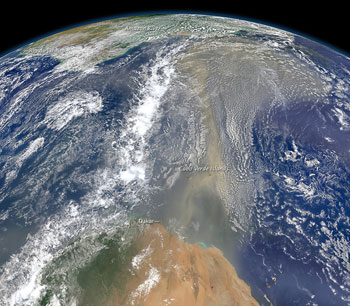
At the same time, the world’s dust production, as a whole, also has risen and fallen. Scientists drilling ice cores in Greenland have seen evidence of this. They have found alternating layers of dusty and dust-free ice. These layers go back hundreds of thousands of years.
Swap believes that the Amazon’s forests also have expanded and shrunken many times. Changes in rainfall and temperature likely drove these cycles. But he thinks dust also played a role. An important one.
When dust was plentiful, the Amazon thrived. When dust was scarce, forests could no longer support many of their plant and animal species. Losing those species made ecosystems less diverse. Forests may have even given way to grasslands and shrubs. In other words, Swap says, the Amazon and the Bodélé may have blinked on and off many times in the past, always together, always to the same climate-driven drumbeat.
This raises questions about how the Bodélé will change as the world warms, and how the Amazon will change along with it.
A warmer Earth will have different patterns of wind and rain. If winds over the Bodélé double in speed, the amount of dust they scour out of it could be eight times as high. And if winds over the Bodélé slow down by 50 percent, its rate of dust production could fall to one eighth of what it is now.
Increased rainfall also could snuff out the Bodélé’s dust, by wetting it down.
Washington would very much like to know how the Bodélé will change as the world’s climate fever builds. Changes in the amount of dust, or where the wind carries it, will affect which ecosystems are fertilized and which aren’t. It also will influence how much sunlight — and heat — is absorbed by the atmosphere or reflected out to space. As Earth warms, the Bodélé might make more dust — or it could just as easily make less dust. It could go either way, says Washington: the Bodélé “is very sensitive.”
Power Words
(for more about Power Words, click here)
Amazon The world’s largest rainforest. Located in South America, it covers an area greater than half the size of the United States.
apatite A type of mineral, containing calcium and phosphate, which exists in some rocks and some types of fossils. It also is a component of bones, fish scales,and the hard white enamel of teeth.
atmosphere The envelope of gases surrounding Earth or another planet.
bedrock The thick, solid rock layer than underlies the soil and other broken, rocky materials on Earth’s surface.
calcium A chemical element which is common in minerals of the Earth’s crust and in sea salt. It is also found in bone mineral and teeth, and can play a role in the movement of certain substances into and out of cells.
cell The smallest structural and functional unit of an organism. Typically too small to see with the naked eye, it consists of watery fluid surrounded by a membrane or wall. Animals are made of anywhere from thousands to trillions of cells, depending on their size.
Chad A land-locked nation in North Africa. It sits on the southern edge of the Sahara Desert. During the 1970s and 1980s, it fought a war with the nation of Libya, its neighbor to the north.
chemistry The field of science that deals with the composition, structure and properties of substances and how they interact with one another. Chemists use this knowledge to study unfamiliar substances, to reproduce large quantities of useful substances or to design and create new and useful substances. (about compounds) The term is used to refer to the recipe of a compound, the way it’s produced or some of its properties.
climate The weather conditions prevailing in an area in general or over a long period.
continent (in geology) The huge land masses that sit upon tectonic plates. In modern times, there are six geologic continents: North America, South America, Eurasia, Africa, Australia and Antarctica.
crustaceans Hard-shelled water-dwelling animals including lobsters, crabs and shrimp.
cyanobacteria A type of bacteria that can convert carbon dioxide into other molecules, including oxygen.
desert crust A thin, fragile crust made of microorganisms, lichens and moss. It covers the surface of the dirt in some deserts. These living crusts are common in the western United States.
DNA (short for deoxyribonucleic acid) A long, double-stranded and spiral-shaped molecule inside most living cells that carries genetic instructions. It is built on a backbone of phosphorus, oxygen, and carbon atoms. In all living things, from plants and animals to microbes, these instructions tell cells which molecules to make.
dissolve To turn a solid into a liquid and disperse it into that starting liquid. For instance, sugar or salt crystals (solids) will dissolve into water. Now the crystals are gone and the solution is a fully dispersed mix of the liquid form of the sugar or salt in water.
ecology A branch of biology that deals with the relations of organisms to one another and to their physical surroundings. A scientist who works in this field is called an ecologist.
ecosystem A group of interacting living organisms — including microorganisms, plants and animals — and their physical environment within a particular climate. Examples include tropical reefs, rainforests, alpine meadows and polar tundra.
environment The sum of all of the things that exist around some organism or the process and the condition those things create for that organism or process. Environment may refer to the weather and ecosystem in which some animal lives, or, perhaps, the temperature, humidity and placement of components in some electronics system or product.
erosion The process that removes rock and soil from one spot on Earth’s surface and then deposits the material elsewhere. Erosion can be exceptionally fast or exceedingly slow. Causes of erosion include wind, water (including rainfall and floods), the scouring action of glaciers, and the repeated cycles of freezing and thawing that often occur in some areas of the world.
europium A rare chemical element that appears as a silver metal when it is pure. It is found in some minerals, and can be used to trace the source of mineral grains carried long distances by water or wind.
fertilizer Nitrogen, phosphorusand other plant nutrients added to soil, water, or foliage to boost crop growth or to replenish nutrients that are removed earlier by plant roots or erosion.
food web (also known as a food chain) The network of relationships among organisms sharing anecosystem. Member organisms depend on others within this network as a source of food.
genetic Having to do with chromosomes, DNA and the genes contained within DNA. The field of science dealing with these biological instructions is known as genetics. People who work in this field are geneticists.
howler monkey A group of monkey species found in Central and South America, including the Amazon. They are well-known for their loud howling, which can sometimes be heard several kilometers (miles) away.
krill Tiny crustaceans that live in the ocean and are the main food source of some whales.
lichen A blend of a fungus and an alga. Neither of these organisms is a plant; the lichen isn’t a plant either. Slow-growing, lichens live on the surface of rocks, trees or wood over many years. Lichens are a component of the soil crusts or “desert crusts” that cover the soil in some deserts.
membrane The outer covering of a cells. It serves as a barrier which blocks the passage (or flow through of) some materials depending on their size or other features.
mineral The crystal-forming substances, such as quartz, apatite, or various carbonates, that make up rock. Most rocks contain several different minerals mish-mashed together. A mineral usually is solid and stable at room temperatures and has a specific formula, or recipe (with atoms occurring in certain proportions) and a specific crystalline structure (meaning that its atoms are organized in certain regular three-dimensional patterns). (in physiology) The same chemicals that are needed by the body to make and feed tissues to maintain health.
moisture Small amounts of water present in the air, as vapor. It can also be present as a liquid, such as water droplets condensed on the inside of a window, or dampness present in clothing or soil.
moss A small, flowerless green plant that lacks true roots. It tends to grow as carpets or rounded cushions in damp habitats. It can reproduce asexually, through fragmentation, or by means of spores released from stalked capsules.
neodymium A chemical element which appears as a soft, silvery metal when it is pure. It is found in some minerals, and can be used to trace the source of mineral grains carried long distances by water or wind. Its scientific symbol is Nd.
nomad The name for someone who has not settled into any community or fixed site, but instead lives by moving from place to place over the course of a year in search of food and shelter.
nutrient A vitamin, mineral, fat, carbohydrate or protein that a plant, animal or other organism requires as part of its food in order to survive.
organism Any living thing, from elephants and plants to bacteria and other types of single-celled life.
penguin flightless black-and-white bird native to the far Southern Hemisphere, especially Antarctica and its nearby islands.
phosphorus A highly reactive, nonmetallic element occurring naturally in phosphates. Its scientific symbol is P. It is an important part of many chemicals and structures that are found in cells, such as membranes, and DNA.
phytoplankton Sometimes referred to as microalgae, these are microscopic plants and plant-like organisms that live in the ocean. Most float and reside in regions where sunlight filters down. Much like land-based plants, these organisms contain chlorophyll. They also require sunlight to live and grow. Phytoplankton serve as a base of the oceanic food web.
polysaccharide A type of carbohydrate made from long chains of simple sugars. Examples of polysaccharides include plant starches and cellulose (a structural material in trees). Some microbes produce polysaccharides to form a protective outer covering.
pyramid A monumental structure with a square or triangular base and sloping sides that meet in a point at the top. The best known are those made from stone as royal tombs in ancient Egypt.
Sahara The largest desert on Earth, found in North Africa. It covers an area equal to half of the United States. It produces more airborne dust than any other desert in the world.
sandstone A type of sedimentary rock. It is formed as sand-size grains of mineral grit became compacted or glued together over time.
satellite A moon orbiting a planet or a vehicle or other manufactured object that orbits some celestial body in space.
sedimentary rock A type of rock that forms from accumulated material that has been eroded from other rocks. It often forms from mud, sand, or clay gathered at the bottom of an ocean, lake, or river.
shrub A perennial plant that grows in a generally low, bushy form.
squall A sudden, violent gale of wind and usually rain (or other precipitation).
thorium A naturally radioactive element which appears as a silvery metal when it is pure. It reacts chemically with air, turning black on its surface. It is found in some minerals, and can be used to trace the source of some mineral grains that are carried long distances by water or wind. Its scientific symbol is Th.
volcano A place on Earth’s crust that opens, allowing magma and gases to spew out from underground reservoirs of molten material. The magma rises through a system of pipes or channels, sometimes spending time in chambers where it bubbles with gas and undergoes chemical transformations. This plumbing system can become more complex over time. This can result in a change, over time, to the chemical composition of the lava as well. The surface around a volcano’s opening can grow into a mound or cone shape as successive eruptions send more lava onto the surface, where it cools into hard rock.
VW Gol A small car that is sold by the company Volkswagen in the South American country of Brazil.
whale A common, but fairly imprecise, term for a class of large mammals that lives in the ocean. This group includes dolphins.
Word Find (click here to enlarge for printing)
